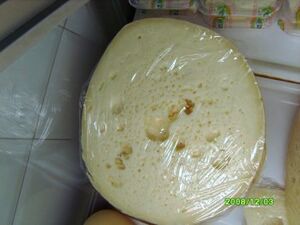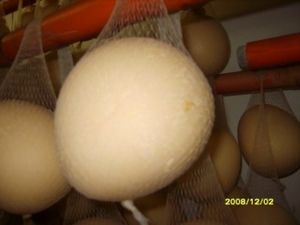Pallone di Gravina facts for kids
Pallone di Gravina is a special kind of cheese from southern Italy. It's a firm, semi-hard cheese made from cow's milk. This cheese comes from the regions of Basilicata and Apulia.
It's shaped like a ball or a pear, and its name 'pallone' means 'balloon' in Italian. Each cheese usually weighs between 1.5 and 2.5 kilograms. This cheese was first made in the Gravina area, but now it's mostly produced near Matera.
In 2016, people tried to get this cheese a special status called PDO from the European Union. This means it would be protected, and only cheese made in a certain way in a specific area could be called Pallone di Gravina. It was also recognized by the Slow Food International organization in 2012. This group helps protect traditional foods.
What Pallone di Gravina Looks Like
The outside of the cheese, called the rind, is hard and smooth. It starts out a straw-yellow color. As the cheese gets older, the rind turns a darker brown.
The inside of the cheese is firm. It also starts as a straw-yellow color. Over time, it becomes a beautiful golden color. This cheese tastes best after it has been aged for at least twelve months.
Ingredients for Pallone di Gravina
The main ingredient for this cheese is full cream cow's milk. This milk can be pasteurized or not. It can come from one or two milkings.
To make the milk turn into cheese, a special ingredient is used. This is called a curdling agent. It can be a liquid from calves or a paste from young goats or lambs. The third important ingredient is salt.
How Pallone di Gravina is Made
Making Pallone di Gravina is similar to how caciocavallo cheese is made. First, the milk is warmed up. Then, the curdling agent is added to make the milk curdle. The curds are the solid parts of the milk.
These curds are put into a special basket with holes, like a colander. After a few hours, when the curds are ready, they are sliced. Then, they are 'spun' in hot water. This is a special method called pasta filata.
After spinning, the cheese pieces are shaped by hand into their famous ball or pear shape. Next, the 'balloons' are put in salty water, called brine, for 12 to 20 hours. The time depends on how big the cheese is.
Finally, the cheeses are left to dry for about 15 days in the dairy. After that, they are moved to a cool cellar to age. This aging process helps the cheese develop its full flavor.



